Covalent Functionalization of Layered Double Hydroxides to Generate Peptide-Based SARS-CoV-2 Nanovaccine
Abstract
1. Introduction
2. Materials and Methods
2.1. Synthesis of Magnesium-Aluminum LDH (Mg-Al LDH) Nanoparticles (NPs)
2.2. Functionalization of LDHs with Organosilanes
2.3. Reductive Amination with Glutaraldehyde
2.4. Active Conjugation of Lysine and Peptides
2.5. Quantification of Primary Amines and Peptides
2.6. Immunization Scheme in Mice
2.7. IgG Titer Quantification by ELISA
2.8. Cytotoxicity Assay
2.9. Characterization
2.10. Statistical Analysis
3. Results and Discussion
3.1. LDH Nanoparticles Synthesized
3.2. LDHs Functionalized by Silanization
3.3. Binding Glutaraldehyde to LDH-NH2
3.4. Binding Lysine or Peptides to LDH-CHO
3.5. Cytotoxicity and Immunogenicity
4. Conclusions
Author Contributions
Funding
Institutional Review Board Statement
Informed Consent Statement
Data Availability Statement
Conflicts of Interest
References
- Delany, I.; Rappuoli, R.; De Gregorio, E. Vaccines for the 21st century. EMBO Mol. Med. 2014, 6, 708–720. [Google Scholar] [CrossRef] [PubMed]
- Moyle, P.M.; Toth, I. Modern subunit vaccines: Development, components, and research opportunities. ChemMedChem 2013, 8, 360–376. [Google Scholar] [CrossRef]
- Hansson, M.; Nygren, P.A.K.; Ståhl, S. Design and production of recombinant subunit vaccines. Biotechnol. Appl. Biochem. 2000, 32, 95–107. [Google Scholar] [CrossRef]
- Moisa, A.A.; Kolesanova, E.F. Synthetic peptide vaccines. Biochem. (Moscow) Suppl. Ser. B Biomed. Chem. 2010, 4, 321–332. [Google Scholar] [CrossRef]
- Food and Drug Administration. Vaccines Licensed for Use in the United States. 2025. Available online: https://www.fda.gov/vaccines-blood-biologics/vaccines/vaccines-licensed-use-united-states (accessed on 27 February 2025).
- Apostolopoulos, V.; Chavda, V.P. Subunit protein-based vaccines. In Advanced Vaccination Technologies for Infectious and Chronic Diseases; Chavda, V.P., Vora, L.K., Apostolopoulos, V., Eds.; Academic Press: London, UK, 2024; pp. 51–62. [Google Scholar]
- Rosales-Mendoza, S.; González-Ortega, O. Nanovaccines: An Innovative Technology to Fight Human and Animal Diseases; Springer: Cham, Switzerland, 2019; 343p. [Google Scholar]
- Govea-Alonso, D.O.; García-Soto, M.J.; Betancourt-Mendiola, L.; Padilla-Ortega, E.; Rosales-Mendoza, S.; González-Ortega, O. Nanoclays: Promising materials for vaccinology. Vaccines 2022, 10, 1549. [Google Scholar] [CrossRef] [PubMed]
- Jing, G.; Yang, L.; Wang, H.; Niu, J.; Li, Y.; Wang, S. Interference of layered double hydroxide nanoparticles with pathways for biomedical applications. Adv. Drug Delivery Rev. 2022, 188, 114451. [Google Scholar] [CrossRef]
- Gu, Z.; Atherton, J.J.; Xu, Z.P. Hierarchical layered double hydroxide nanocomposites: Structure, synthesis and applications. Chem. Commun. 2015, 51, 3024–3036. [Google Scholar] [CrossRef]
- Rives, V.; Ulibarri, M.A. Layered double hydroxides (LDH) intercalated with metal coordination compounds and oxometalates. Coord. Chem. Rev. 1999, 181, 61–120. [Google Scholar] [CrossRef]
- Martínez, D.R.; Carbajal, G.G. Hidróxidos dobles laminares: Arcillas sintéticas con aplicaciones en nanotecnología. Av. Quim. 2012, 7, 87–99. [Google Scholar]
- Pavlovic, M.; Szerlauth, A.; Muráth, S.; Varga, G.; Szilagyi, I. Surface modification of two-dimensional layered double hydroxide nanoparticles with biopolymers for biomedical applications. Adv. Drug Delivery Rev. 2022, 191, 114590. [Google Scholar] [CrossRef]
- Zhang, L.X.; Hu, J.; Jia, Y.B.; Liu, R.T.; Cai, T.; Xu, Z.P. Two-dimensional layered double hydroxide nanoadjuvant: Recent progress and future direction. Nanoscale 2021, 13, 7533–7549. [Google Scholar] [CrossRef] [PubMed]
- Li, A.; Qin, L.; Zhu, D.; Zhu, R.; Sun, J.; Wang, S. Signalling pathways involved in the activation of dendritic cells by layered double hydroxide nanoparticles. Biomaterials 2010, 31, 748–756. [Google Scholar] [CrossRef] [PubMed]
- Wu, P.; Zhang, Y.; Yin, X.; He, Y.; Zhang, Q.; Chen, C. Layered double hydroxide nanoparticles as an adjuvant for inactivated foot-and-mouth disease vaccine in pigs. BMC Vet. Res. 2020, 16, 474. [Google Scholar] [CrossRef]
- Zhang, L.X.; Sun, X.M.; Jia, Y.B.; Liu, X.G.; Dong, M.; Xu, Z.P.; Liu, R.T. Nanovaccine’s rapid induction of anti-tumor immunity significantly improves malignant cancer immunotherapy. Nano Today 2020, 35, 100923. [Google Scholar] [CrossRef]
- Govea-Alonso, D.O.; García-Soto, M.J.; Mendoza-Pérez, E.S.; Farfán-Castro, S.; Fuente, D.; González-Ortega, O.; Rosales-Mendoza, S. Assessing the adjuvant effect of layered double hydroxides (LDH) on BALB/c mice. Materials 2023, 16, 5467. [Google Scholar] [CrossRef]
- Wang, J.; Zhu, R.; Gao, B.; Wu, B.; Li, K.; Sun, X.; Liu, H.; Wang, S. The enhanced immune response of hepatitis B virus DNA vaccine using SiO2@LDH nanoparticles as an adjuvant. Biomaterials 2014, 35, 466–478. [Google Scholar] [CrossRef]
- Dong, Y.; Chen, L.; Hou, J.; Sun, Y.; Han, Z.; Zhang, J.; Liang, Y.; Feng, Y.; Ren, J.; Li, Q.; et al. DNA programmed Mg-Al layered double hydroxide-based bi-adjuvant nanovaccines. Nano Today 2024, 57, 102352. [Google Scholar] [CrossRef]
- Yan, S.; Gu, W.; Zhang, B.; Rolfe, B.E.; Xu, Z.P. High adjuvant activity of layered double hydroxide nanoparticles and nanosheets in anti-tumour vaccine formulations. Dalton Trans. 2018, 47, 2956–2964. [Google Scholar] [CrossRef]
- Zhang, L.X.; Jia, Y.B.; Huang, Y.R.; Liu, H.N.; Sun, X.M.; Cai, T.; Liu, R.T.; Xu, Z.P. Efficient delivery of clay-based nanovaccines to the mouse spleen promotes potent anti-tumor immunity for both prevention and treatment of lymphoma. Nano Res. 2021, 14, 1326–1334. [Google Scholar] [CrossRef]
- Zhang, L.X.; Xie, X.X.; Liu, D.Q.; Xu, Z.P.; Liu, R.T. Efficient co-delivery of neo-epitopes using dispersion-stable layered double hydroxide nanoparticles for enhanced melanoma immunotherapy. Biomaterials 2018, 174, 54–66. [Google Scholar] [CrossRef]
- Chen, W.; Zuo, H.; Rolfe, B.; Schembri, M.A.; Cobbold, R.N.; Zhang, B.; Mahony, T.J.; Xu, Z.P. Clay nanoparticles co-deliver three antigens to promote potent immune responses against pathogenic Escherichia coli. J. Control. Release 2018, 292, 196–209. [Google Scholar] [CrossRef] [PubMed]
- Alonso-Cerda, M.J.; García-Soto, M.J.; Miranda-López, A.; Segura-Velázquez, R.; Sánchez-Betancourt, J.I.; González-Ortega, O.; Rosales-Mendoza, S. Layered double hydroxides (LDH) as delivery vehicles of a chimeric protein carrying epitopes from the Porcine Reproductive and Respiratory Syndrome Virus. Pharmaceutics 2024, 16, 841. [Google Scholar] [CrossRef] [PubMed]
- Chen, W.; Zhang, B.; Mahony, T.; Gu, W.; Rolfe, B.; Xu, Z.P. Efficient and durable vaccine against intimin β of diarrheagenic E. coli induced by clay nanoparticles. Small 2016, 12, 1627–1639. [Google Scholar] [CrossRef] [PubMed]
- Chen, W.Y.; Zuo, H.L.; Mahony, T.J. Efficient induction of comprehensive immune responses to control pathogenic E. coli by clay nano-adjuvant with the moderate size and surface charge. Sci. Rep. 2017, 7, 13367. [Google Scholar] [CrossRef]
- Deng, X.; He, J.; Xu, J.; Wang, Y.; Yi, J.; Zhang, H.; Wang, Y.; Wang, Z.; Chen, C. LDH as an adjuvant makes Brucella outer-membrane vesicles and outer-membrane vesicle-associated proteins highly protective in mice. Iran. J. Basic Med. Sci. 2023, 26, 564. [Google Scholar]
- Li, D.; Xu, M.; Li, G.; Zheng, Y.; Zhang, Y.; Xia, D.; Wang, S.; Chen, Y. Mg/Al-LDH as a nano-adjuvant for pertussis vaccine: A evaluation compared with aluminum hydroxide adjuvant. Nanotechnology 2022, 33, 235102. [Google Scholar] [CrossRef]
- Zhang, L.X.; Liu, D.Q.; Wang, S.W.; Yu, X.L.; Ji, M.; Xie, X.X.; Liu, S.Y.; Liu, R.T. MgAl-layered double hydroxide nanoparticles co-delivering siIDO and Trp2 peptide effectively reduce IDO expression and induce cytotoxic T-lymphocyte responses against melanoma tumor in mice. J. Mater. Chem. B 2017, 5, 6266–6276. [Google Scholar] [CrossRef]
- Hermanson, G.T. Bioconjugate Techniques, 3rd ed.; Academic Press: London, UK, 2013; 1146p. [Google Scholar]
- Ádok-Sipiczki, M.; Szilagyi, I.; Pálinkó, I.; Pavlovic, M.; Sipos, P.; Nardin, C. Design of nucleic acid-layered double hydroxide nanohybrids. Colloid Polym. Sci. 2017, 295, 1463–1473. [Google Scholar] [CrossRef]
- Farfán-Castro, S.; García-Soto, M.J.; Betancourt-Mendiola, L.; Cervantes, J.; Segura, R.; González-Ortega, O.; Rosales-Mendoza, S. Synthesis and evaluation of gold nanoparticles conjugated with five antigenic peptides derived from the spike protein of SARS-CoV-2 for vaccine development. Front. Nanotechnol. 2024, 6, 1335346. [Google Scholar] [CrossRef]
- Xu, Z.P.; Stevenson, G.S.; Lu, C.Q.; Lu, G.Q.; Bartlett, P.F.; Gray, P.P. Stable suspension of layered double hydroxide nanoparticles in aqueous solution. J. Am. Chem. Soc. 2006, 128, 36–37. [Google Scholar] [CrossRef]
- Chhetri, S.; Chandra Adak, N.; Samanta, P.; Chandra Murmu, N.; Kuila, T. Rheological, mechanical, and thermal properties of silane grafted layered double hydroxide/epoxy composites. Ind. Eng. Chem. Res. 2018, 57, 8729–8739. [Google Scholar] [CrossRef]
- Moore, S.; Stein, W.H. A modified ninhydrin reagent for the photometric determination of amino acids and related compounds. J. Biol. Chem. 1954, 211, 907–913. [Google Scholar] [CrossRef] [PubMed]
- Yan, S.; Rolfe, B.E.; Zhang, B.; Mohammed, Y.H.; Gu, W.; Xu, Z.P. Polarized immune responses modulated by layered double hydroxides nanoparticle conjugated with CpG. Biomaterials 2014, 35, 9508–9516. [Google Scholar] [CrossRef] [PubMed]
- Yan, L.; Wang, Y.; Li, J.; Kalytchuk, S.; Susha, A.S.; Kershaw, S.V.; Yan, F.; Rogach, A.L.; Chen, X. Highly luminescent covalently bonded layered double hydroxide–fluorescent dye nanohybrids. J. Mater. Chem. C 2014, 2, 4490–4494. [Google Scholar] [CrossRef]
- Mishra, P.; Pandey, C.M.; Singh, U.; Gupta, A.; Sahu, C.; Keshri, A. Descriptive statistics and normality tests for statistical data. Ann. Card. Anaesth. 2019, 22, 67–72. [Google Scholar]
- Sahoo, M.; Singha, S.; Parida, K.M. Amine functionalized layered double hydroxide: A reusable catalyst for aldol condensation. New J. Chem. 2011, 35, 2503–2509. [Google Scholar] [CrossRef]
- Carrasco, J.A.; Seijas-Da Silva, A.; Oestreicher, V.; Romero, J.; Márkus, B.G.; Simon, F.; Vieira, B.J.; Waerenborgh, J.C.; Abellán, G.; Coronado, E. Fundamental insights into the covalent silane functionalization of NiFe layered double hydroxides. Chem. A Eur. J. 2020, 26, 6504–6517. [Google Scholar] [CrossRef]
- Aminifazl, A.; Karunarathne, D.J.; Golden, T.D. Synthesis of silane functionalized LDH-modified nanopowders to improve compatibility and enhance corrosion protection for epoxy coatings. Molecules 2024, 29, 819. [Google Scholar] [CrossRef]
- Dinari, M.; Neamati, S. Surface modified layered double hydroxide/polyaniline nanocomposites: Synthesis, characterization and Pb2+ removal. Colloids Surf. A 2020, 589, 124438. [Google Scholar] [CrossRef]
- Tao, Q.; He, H.; Li, T.; Frost, R.L.; Zhang, D.; He, Z. Tailoring surface properties and structure of layered double hydroxides using silanes with different number of functional groups. J. Solid State Chem. 2014, 213, 176–181. [Google Scholar] [CrossRef]
- Islam, M.R.; Guo, Z.; Rutman, D.; Benson, T.J. Immobilization of triazabicyclodecene in surfactant modified Mg/Al layered double hydroxides. RSC Adv. 2013, 3, 24247–24255. [Google Scholar] [CrossRef]
- Yu, M.; Du, N.; Hou, W. Model prediction of the point of zero net charge of layered double hydroxides and clay minerals. Colloids Surf. A Physicochem. Eng. Aspects 2021, 611, 125860. [Google Scholar] [CrossRef]
- Valente, J.S.; Rodriguez-Gattorno, G.; Valle-Orta, M.; Torres-Garcia, E. Thermal decomposition kinetics of MgAl layered double hydroxides. Mater. Chem. Phys. 2012, 133, 621–629. [Google Scholar] [CrossRef]
- Kloprogge, J.T.; Frost, R.L. Fourier transform infrared and Raman spectroscopic study of the local structure of Mg-, Ni-, and Co-hydrotalcites. J. Solid State Chem. 1999, 146, 506–515. [Google Scholar] [CrossRef]
- Luengo, C.V.; Volpe, M.A.; Avena, M.J. High sorption of phosphate on Mg-Al layered double hydroxides: Kinetics and equilibrium. J. Env. Chem. Eng. 2017, 5, 4656–4662. [Google Scholar] [CrossRef]
- Yang, K.; Yan, L.G.; Yang, Y.M.; Yu, S.J.; Shan, R.R.; Yu, H.Q.; Zhu, B.C.; Du, B. Adsorptive removal of phosphate by Mg–Al and Zn–Al layered double hydroxides: Kinetics, isotherms and mechanisms. Sep. Pur. Technol. 2014, 124, 36–42. [Google Scholar] [CrossRef]
- Campos, E.; Coimbra, P.; Gil, M.H. An improved method for preparing glutaraldehyde cross-linked chitosan–poly (vinyl alcohol) microparticles. Polym. Bull. 2013, 70, 549–561. [Google Scholar] [CrossRef]
- Abdelgalil, R.M.; Khattab, S.N.; Ebrahim, S.; Elkhodairy, K.A.; Teleb, M.; Bekhit, A.A.; Sallam, M.A.; Elzoghby, A.O. Engineered sericin-tagged layered double hydroxides for combined delivery of pemetrexed and ZnO quantum dots as biocompatible cancer nanotheranostics. ACS Omega 2023, 8, 5655–5671. [Google Scholar] [CrossRef]
- Hinton, T.M.; Grusche, F.; Acharya, D.; Shukla, R.; Bansal, V.; Waddington, L.J.; Monaghan, P.; Muir, B.W. Bicontinuous cubic phase nanoparticle lipid chemistry affects toxicity in cultured cells. Toxicol. Res. 2014, 3, 11–22. [Google Scholar] [CrossRef]
- ISO 19007:2018(en); Nanotechnologies—In Vitro MTS Assay for Measuring the Cytotoxic Effect of Nanoparticles. International Organization for Standardization: Geneva, Switzerland, 2018. Available online: https://www.iso.org/obp/ui/en/#iso:std:iso:19007:ed-1:v1:en (accessed on 27 February 2025).

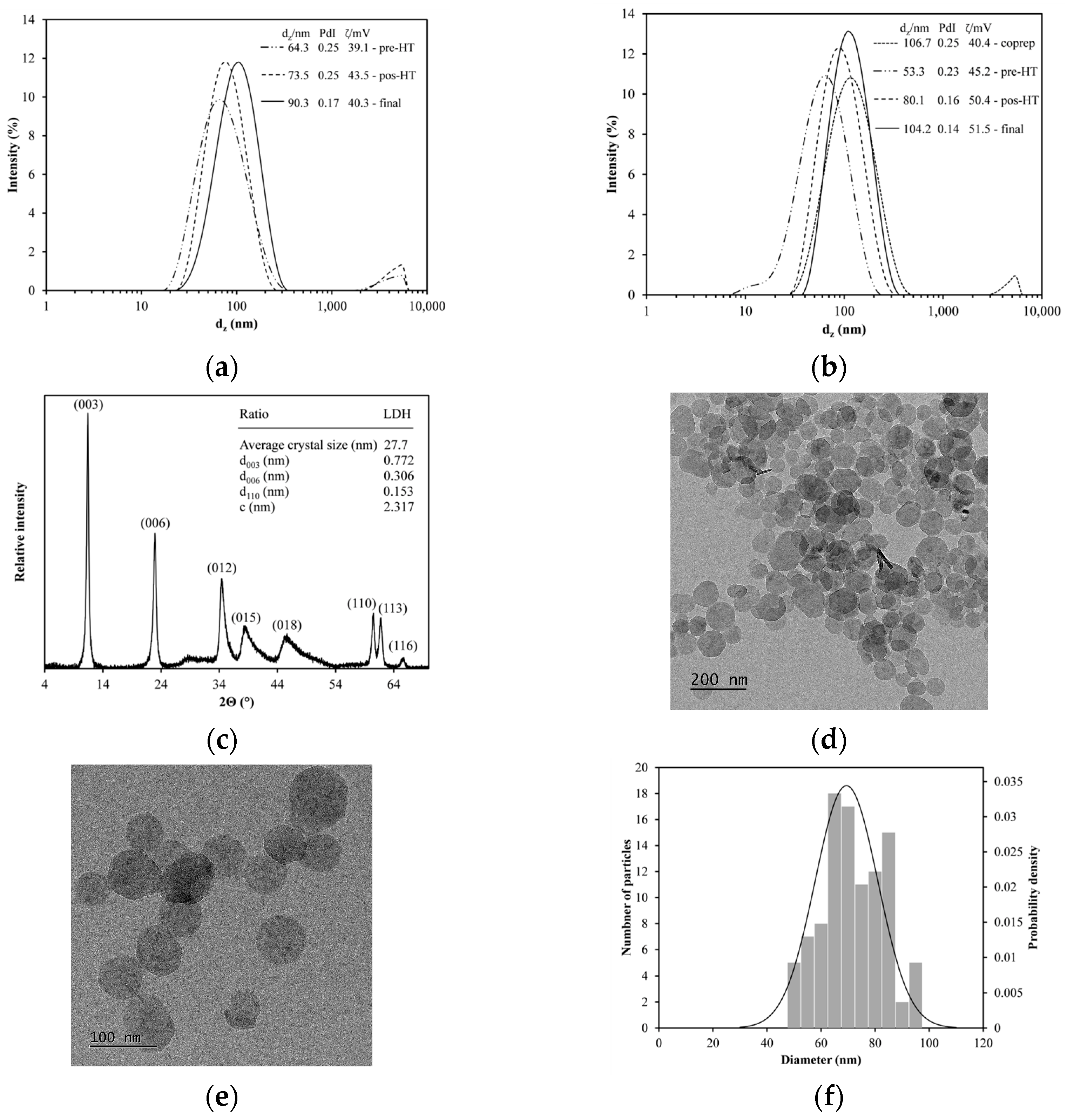
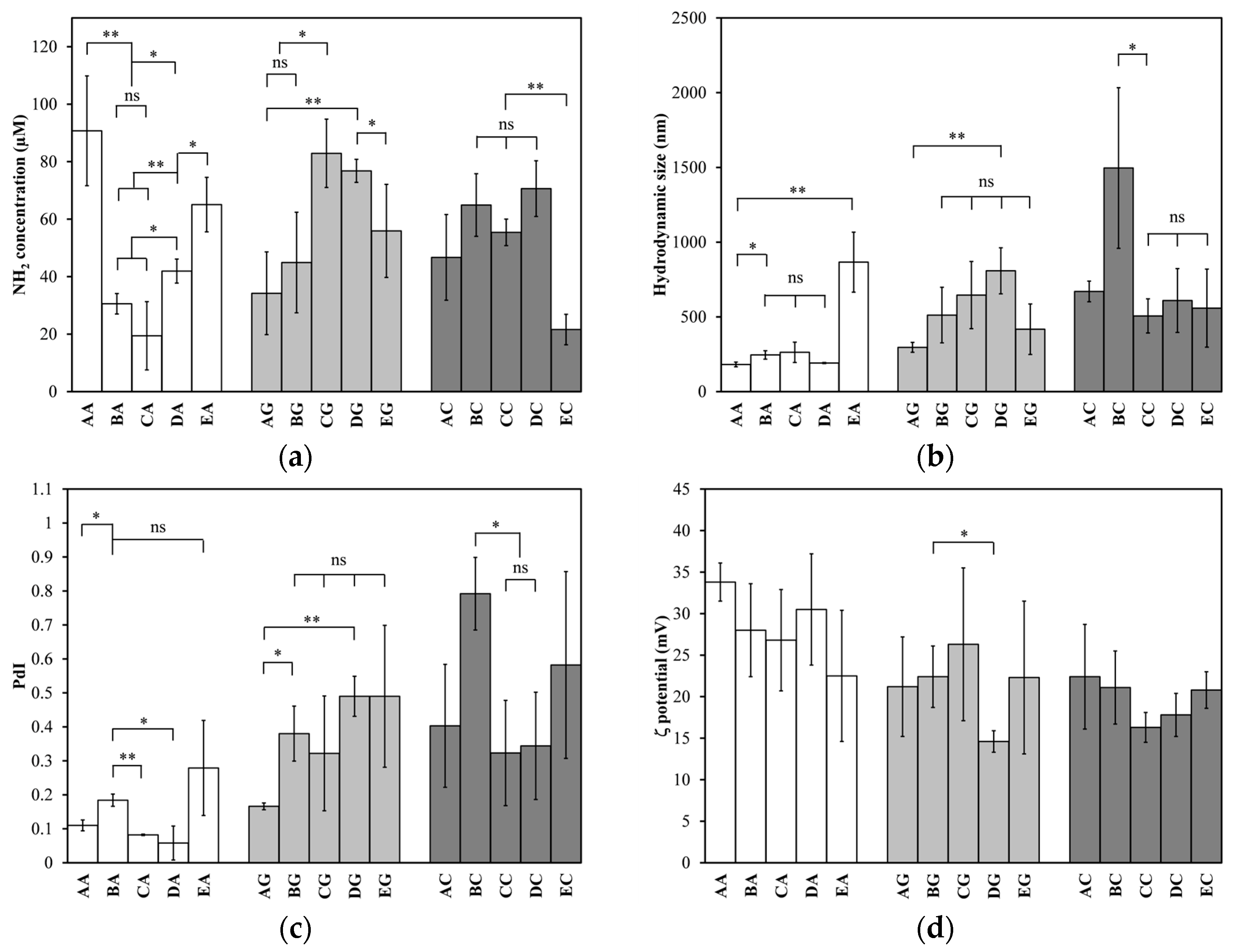
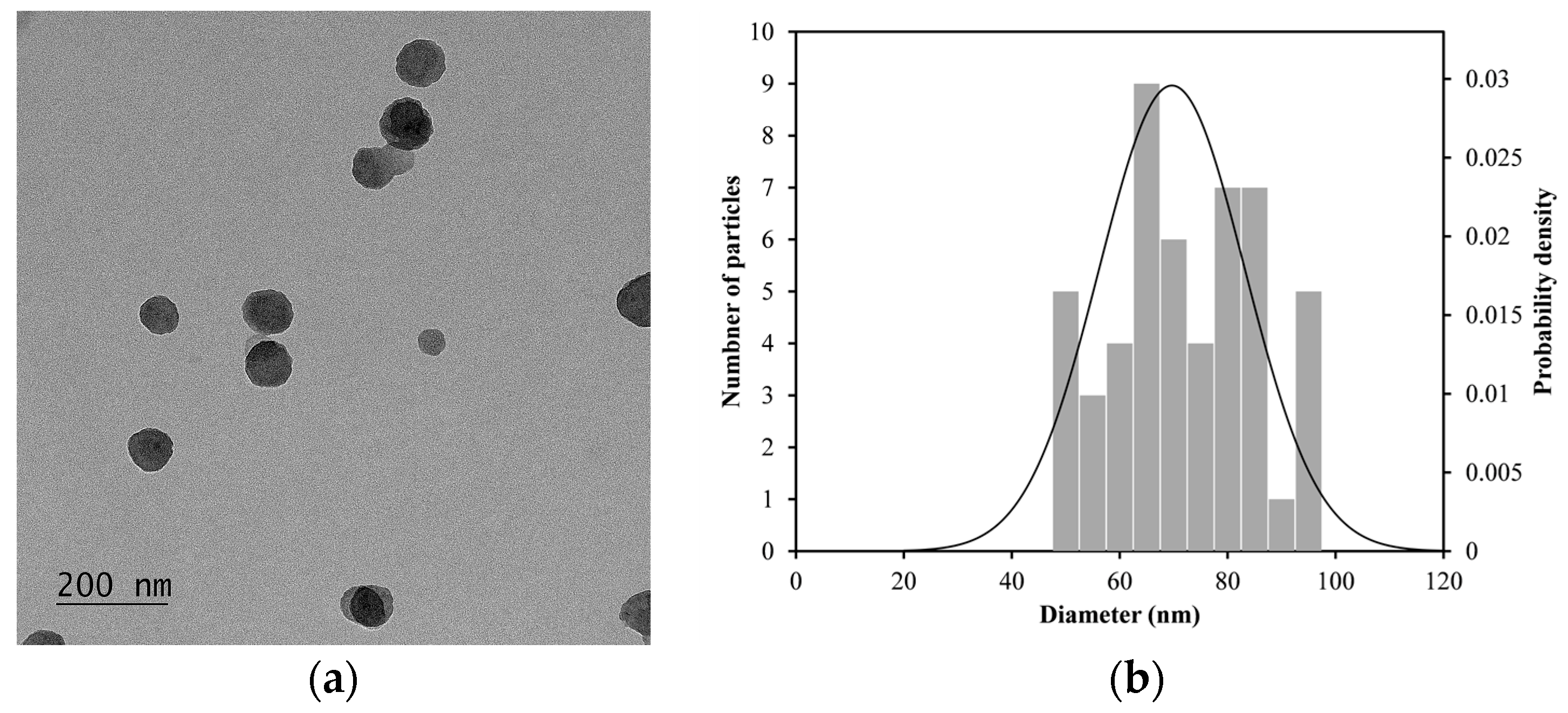



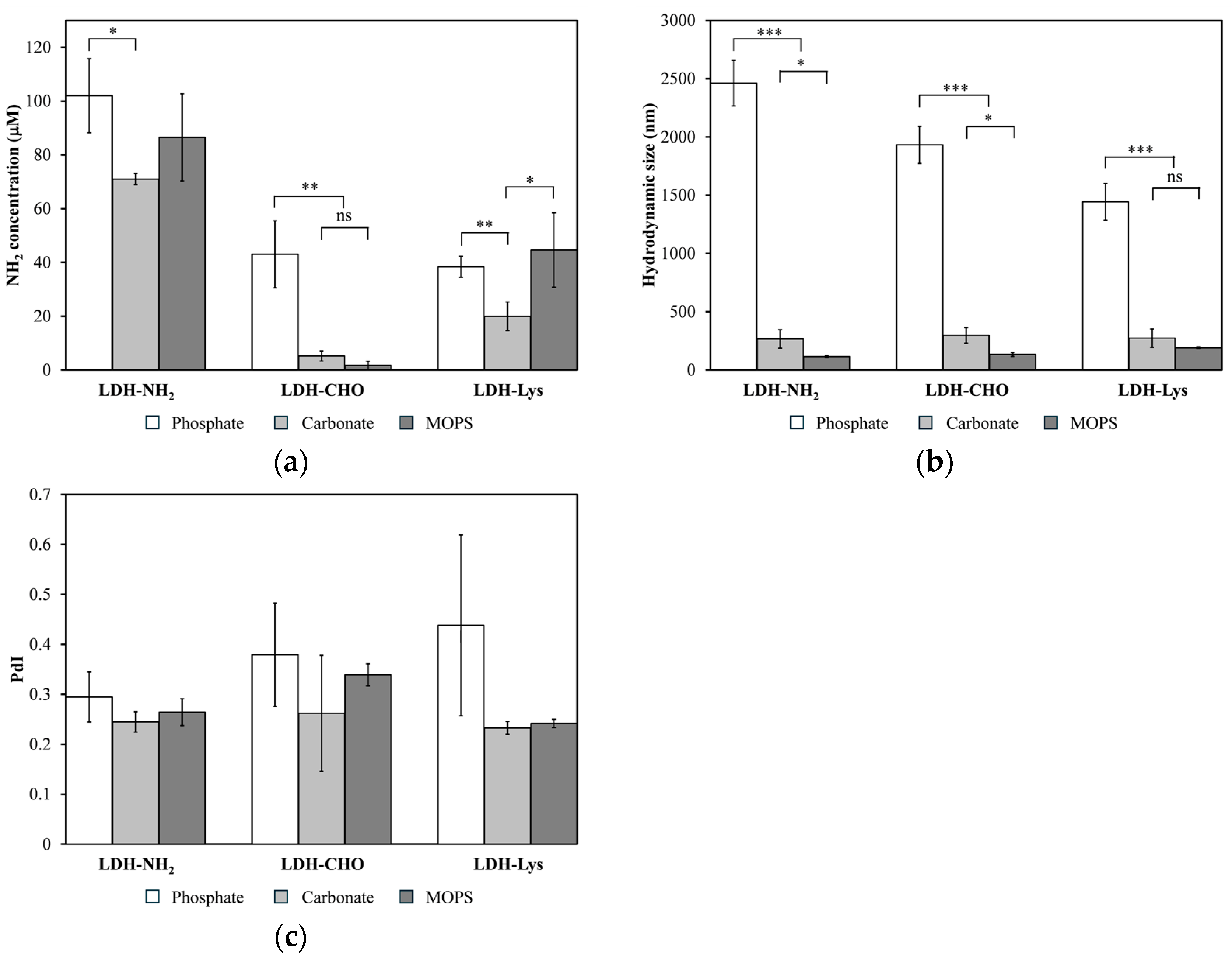


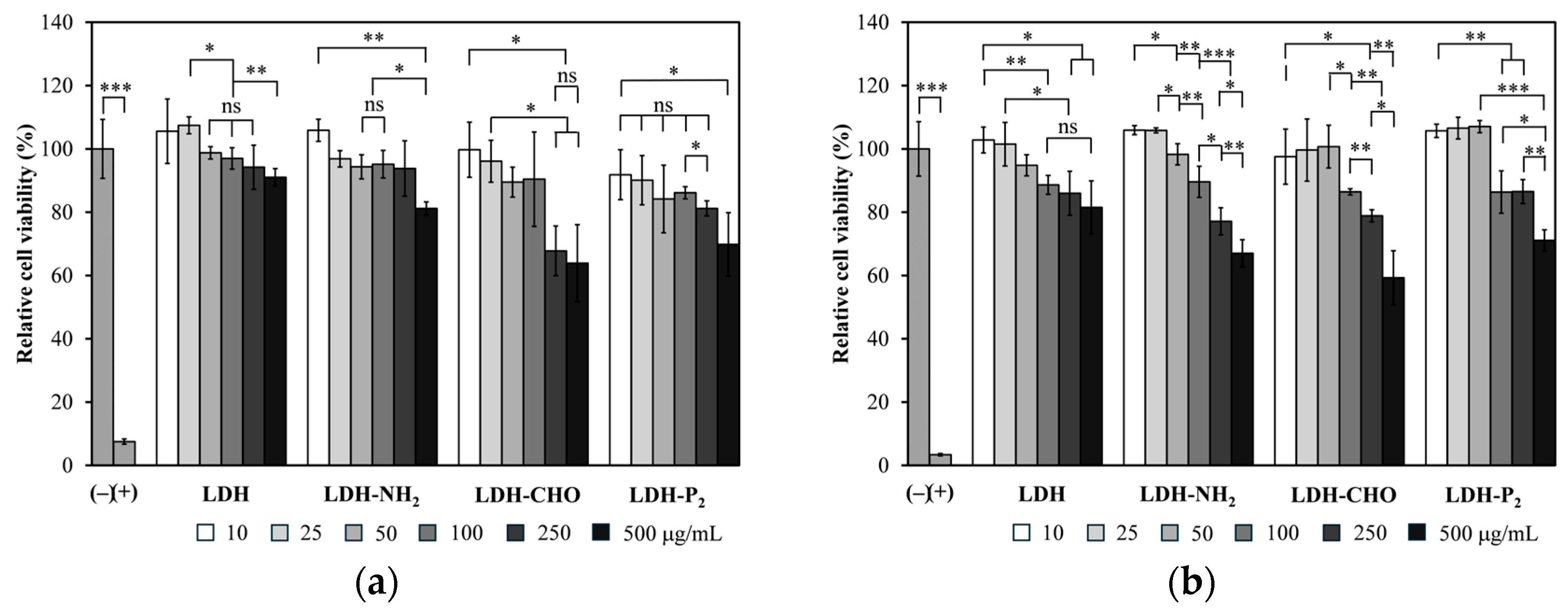

| Conjugate | Peptide Concentration (µg/mL) | dz (nm) | PdI |
|---|---|---|---|
| LDH-P2 | 125 ± 16 | 428 ± 64 | 0.21 ± 0.10 |
| LDH-P5 | 270 ± 124 | 252 ± 30 | 0.14 ± 0.04 |
| Sample | Element | C | Mg | Al | Si |
|---|---|---|---|---|---|
| LDH-NH2 | Weight% | 13.88 | 18.65 | 6.34 | 7.69 |
| Atomic% | 19.87 | 13.22 | 4.05 | 4.71 | |
| %DESV | 2.13 | 1.74 | 0.50 | 0.90 | |
| LDH-CHO | Weight% | 21.62 | 15.50 | 6.05 | 0.21 |
| Atomic% | 29.35 | 10.44 | 3.67 | 0.12 | |
| %DESV | 4.14 | 1.25 | 0.50 | 0.07 | |
| LDH-P2 | Weight% | 28.60 | 12.57 | 6.69 | 0.16 |
| Atomic% | 37.49 | 8.14 | 3.90 | 0.09 | |
| %DESV | 4.26 | 1.20 | 0.48 | 0.03 |
| Sample | Mg/Al | Si/LDH | C/LDH | Mg/Si | Mg/C |
|---|---|---|---|---|---|
| LDH-NH2 | 3.261 | 0.273 | 1.150 | 2.806 | 0.665 |
| LDH-CHO | 2.842 | 0.009 | 2.079 | 85.590 | 0.356 |
| LDH-P2 | 2.087 | 0.007 | 3.114 | 90.444 | 0.217 |
Disclaimer/Publisher’s Note: The statements, opinions and data contained in all publications are solely those of the individual author(s) and contributor(s) and not of MDPI and/or the editor(s). MDPI and/or the editor(s) disclaim responsibility for any injury to people or property resulting from any ideas, methods, instructions or products referred to in the content. |
© 2025 by the authors. Licensee MDPI, Basel, Switzerland. This article is an open access article distributed under the terms and conditions of the Creative Commons Attribution (CC BY) license (https://creativecommons.org/licenses/by/4.0/).
Share and Cite
Liñán-González, A.E.; Rodríguez-Montelongo, S.A.; García-Soto, M.J.; Gómez-Zarandona, D.; Farfán-Castro, S.; Palestino, G.; Ocampo-Pérez, R.; Padilla-Ortega, E.; González-Ortega, O.; Rosales-Mendoza, S. Covalent Functionalization of Layered Double Hydroxides to Generate Peptide-Based SARS-CoV-2 Nanovaccine. Materials 2025, 18, 2449. https://doi.org/10.3390/ma18112449
Liñán-González AE, Rodríguez-Montelongo SA, García-Soto MJ, Gómez-Zarandona D, Farfán-Castro S, Palestino G, Ocampo-Pérez R, Padilla-Ortega E, González-Ortega O, Rosales-Mendoza S. Covalent Functionalization of Layered Double Hydroxides to Generate Peptide-Based SARS-CoV-2 Nanovaccine. Materials. 2025; 18(11):2449. https://doi.org/10.3390/ma18112449
Chicago/Turabian StyleLiñán-González, Alejandra E., Sayma A. Rodríguez-Montelongo, Mariano J. García-Soto, Daniela Gómez-Zarandona, Susan Farfán-Castro, Gabriela Palestino, Raúl Ocampo-Pérez, Erika Padilla-Ortega, Omar González-Ortega, and Sergio Rosales-Mendoza. 2025. "Covalent Functionalization of Layered Double Hydroxides to Generate Peptide-Based SARS-CoV-2 Nanovaccine" Materials 18, no. 11: 2449. https://doi.org/10.3390/ma18112449
APA StyleLiñán-González, A. E., Rodríguez-Montelongo, S. A., García-Soto, M. J., Gómez-Zarandona, D., Farfán-Castro, S., Palestino, G., Ocampo-Pérez, R., Padilla-Ortega, E., González-Ortega, O., & Rosales-Mendoza, S. (2025). Covalent Functionalization of Layered Double Hydroxides to Generate Peptide-Based SARS-CoV-2 Nanovaccine. Materials, 18(11), 2449. https://doi.org/10.3390/ma18112449











